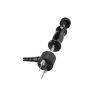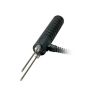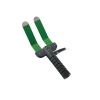Extech MO290 Psychrometer with IR Thermometer
The Extech Pinless Moisture Psychrometer with Built-In InfraRed Thermometer quickly indicates the moisture content of materials using the pinless moisture sensor.
Features
- Works on multiple wood types and other building materials
- Simultaneously displays % moisture and airtemperature, IR temperature, or humidity
- Designed with an IR circuit to measure non-contact surface temperature
- Free ground shipping
- Expedited repair and warranty service
- Lifetime technical support
- More
The Extech Pinless Moisture Psychrometer + IR Thermometer monitors moisture in wood and other building materials with virtually no surface damage using the pinless moisture sensor. The 8-in-1 meter simultaneously displays moisture value of wood or materials being tested, air temperature, IR temperature, and humidity, and works on multiple wood types. It is designed with an IR circuit to measure non-contact surface temperature; 8:1distance to spot ratio with 0.95 fixed emissivity. The built-in humidity/temperature probe measures relative humidity, air temperature plus grains per pound, dew point, vapor pressure, and condensation point.
- Sensor type: non-penetrating
- Pinless moisture: 0 to 99.9 (Relative)
- Pinless depth: Up to 0.75" (19mm)
- Pin-type moisture (probe included): 0 to 99.9%
- Maximum resolution: 0.1, 0.1°F/°C
- Humidity: 0 to 100%
- Air temperature: -20 to 170°F (-29 to 77°C)
- IR temperature: -4 to 392 F (-20 to 200 C)
- Vapor pressure: 0 to 20.0kPA
- Dew point: -22 to 199°F (-30 to 100°C)
- Mixing ratio: 0 to 999GPP (0 to 160g/kg)
- Field of view: 8:1 distance to target ratio
- Emissivity: 0.95 fixed
- Dimensions: 6.5x2.8x1.5 (165x70x38)
- Weight: 7.4oz (210g)
- (1) Meter
- (1) Pin moisture probe with cable
- (1) 9V battery
- (1) Case
In The News
Wildfire Prevention in the Sierra Nevada Region with the Yuba Watershed Institute
Though recent wildfires have sparked new conversations about wildfire management and response, groups like the Yuba Watershed Institute have been monitoring the forests and water resources of the Sierra Nevada region for decades, managing approximately 5,000 acres of land with the Bureau of Land Management (BLM) and about 7,000 acres in private land partnerships. The goal of the Institute is to work with local communities and land agencies to improve watershed and forestry management through informed practices and public outreach. The goals of the Yuba Watershed Institute are three-fold: Improve the ability of fire suppression agencies like the California Department of Forestry and Fire Protection ( CAL FIRE ) and the US Forest Service.
Read MoreWave Sensors Integration with NexSens Buoys: A Cutting-Edge Solution for Wave Measurment
Real-time wave data supports accurate weather prediction, safe and efficient maritime operations, and provides valuable safety and operating condition information for recreation and commercial fishing. Understanding wave dynamics also helps with the design of protective coastal structures like seawalls, breakwaters, and jetties. It also supports better prediction of their impact on sediment transport and coastal geomorphology. Wave data is a key factor in qualifying and designing offshore wind farms and harnessing kinetic energy for electrical generation. It helps with the understanding of ocean-atmosphere interactions and contributes to studies of sea-level rise and climate change impacts.
Read MoreSpring 2025 Environmental Monitor Available Now
In the Spring 2025 edition of the Environmental Monitor, we highlight partnerships across the world and the importance of collaboration between government agencies, universities, environmental groups, local communities, and other stakeholders. From great white shark research in Cape Cod to monitoring fisheries in Lake Erie, this latest edition underscores partnerships that connect stakeholders in a watershed through environmental data. With an emphasis on data sharing, a combination of real-time and discrete sampling keeps the public and partners informed of environmental conditions. Our writers also sought out science professionals dedicated to working with peers within and outside of the environmental sector.
Read More













